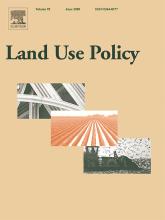Resource information
As the global population continues to increase, rural areas are expected to accommodate future growth at the same time as continuing to feed growing populations. This tension is greatest on those who farm land that is earmarked for future urban growth. Yet, little is known about the attitudes and values of the affected rural farming communities or farmers’ perceptions of the challenges and opportunities that population growth presents. This paper presents the results from a survey of outdoor vegetable growers in Pukekohe, an area under increasing pressure from urban growth, located in Auckland, New Zealand’s fastest growing city. An analysis of rural fragmentation is also provided to demonstrate the extent of land use change to help contextualise growers’ responses. Survey results showed that economic discourses fail to fully capture the symbolic meaning the land has for growers; many participants were deeply connected to the land, with the desire for the farming legacy to continue, while also recognising its highly productive capability. Participating growers identified numerous challenges and opportunities as a consequence of urban growth. Key challenges included: reverse sensitivity associated with development pressures; achieving sustainable productivity and profits; and perceptions of an increasingly bureaucratic legislative environment. Key opportunities included: occupation of a unique vegetable growing environment; capitalising on the area’s close proximity to city markets; and for a minority of participants, possible financial gains through residential housing development. Geospatial analysis demonstrated a large degree of rural fragmentation that can lead to adverse cumulative effects without the intervention of policy. Future research needs to focus on determining the consequences of continuous development pressures onto versatile land in relation to a country’s, current and future, food-growing capacity. This will be imperative as the population continues to grow. It will not only inform the environmental impacts of these land use decisions but also the socio-economic consequences that will aid with fully informed planning, policy and decision-making that account for a multiplicity of needs.


